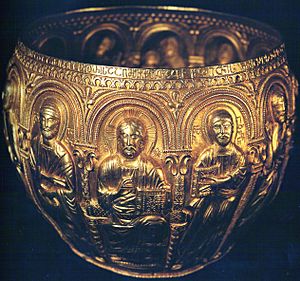Bedia Chalice facts for kids
Quick facts for kids Bedia Chalice |
|
|---|---|
 |
|
| Material | Ducat gold |
| Created | c. 999 |
| Present location | Art Museum of Georgia, Tbilisi |
The Bedia Chalice (Georgian: ბედიის თასი, romanized: bediis tasi) is a very old and special cup from the country of Georgia. It's a religious vessel made of pure gold. This beautiful cup was created around the year 999. King Bagrat III ordered it to be made for the Bedia Monastery in Abkhazia. Today, only the top part of the cup remains. You can see it at the Georgian National Museum in Tbilisi.
A Look at Its History
This special chalice was a gift from King Bagrat III. His mother, Queen Gurandukht, also helped with the gift. They gave it to the new church at Bedia. This church was finished in the year 999.
The bottom part of the cup was lost a long time ago. It was replaced in the 1500s. A bishop named Germane Chkhetidze had it fixed. This is mentioned in an old Georgian writing.
Later, in 1865, a historian named Dimitri Bakradze saw the cup. It was kept safely in the Ilori Church. But the new bottom part disappeared again after that. The top part, which we still have, was moved to Tbilisi. It has been kept in the Georgian National Museum since 1930.
What the Chalice Looks Like
The remaining part of the Bedia Chalice is a bowl. It is about 14 centimeters (5.5 inches) tall. It is also 14 centimeters wide. The bowl weighs about 752 grams (1.6 pounds).
It is made from a single piece of gold. All the pictures and details are made using a special method. This method is called repoussé. It means the designs are hammered from the back. This pushes them out on the front.
The outside of the bowl has 12 sections. These sections are shaped like arches. Inside these arches are different figures. You can see Christ Pantokrator, who is Christ shown as a powerful ruler. On the opposite side is the Virgin Hodegetria. This is a picture of the Virgin Mary holding baby Jesus.
Between Christ and the Virgin Mary are ten apostles. Five stand on each side. They are holding scrolls in their hands. A Greek writing identifies Christ. The apostles are named with Georgian words. There is no writing for the Virgin Mary.
Just below the rim, there is a Georgian writing. It is carved very finely. This writing mentions King Bagrat and Queen Gurandukht. It says they gave this cup. It also mentions them building and decorating the church.
The Bedia Chalice is famous for its beautiful design. It has a clear and balanced look. The decorations are typical of Georgian art. But it also shares some styles with Byzantine art from that time. These include ivory carvings and special enameled cups. You can see similar items in the Treasury of San Marco in Venice. However, the Bedia Chalice has a strong and grand feeling that is quite unique.

